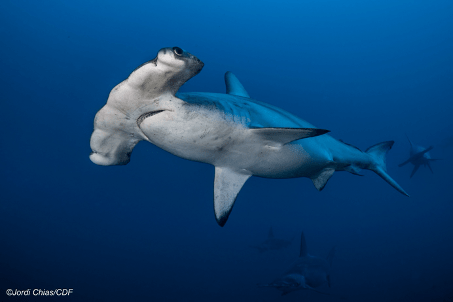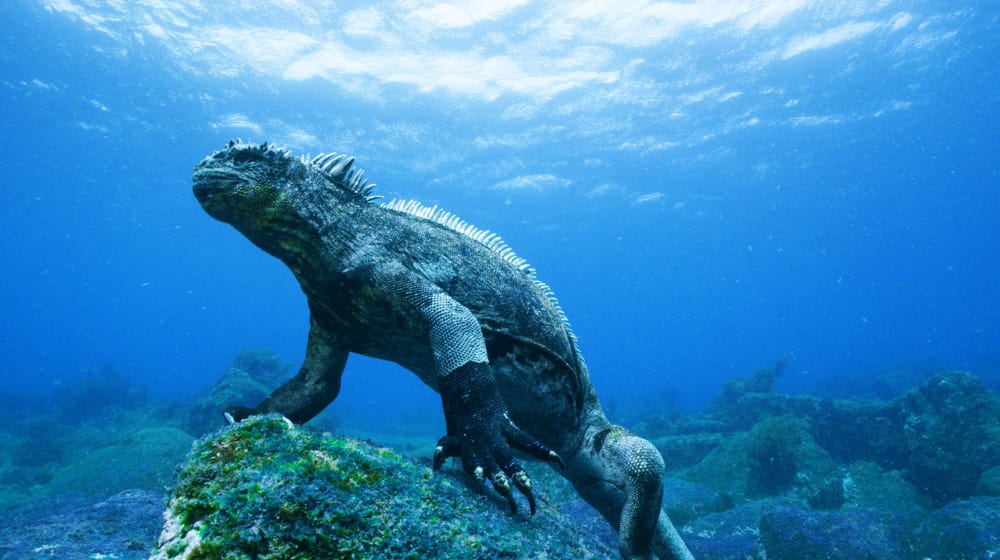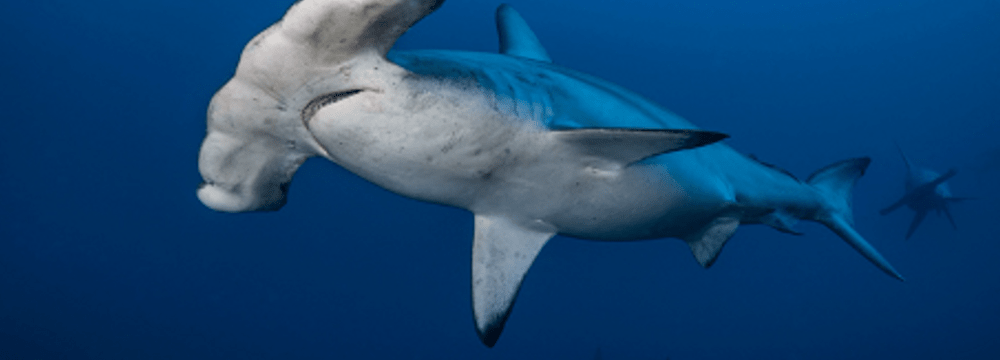
Webinar "Shark Ecology Project"
As it is currently not possible to travel to the Galapagos Islands due to the Corona Pandemic, the team of the Charles Darwin Foundation has decided to present existing protection projects in the form of webinars to friends and sponsors of this unique archipelago. The first webinar about the "Shark Ecology Project" took place on June 8th, 2020 and was presented by the Ecuadorian marine biologist Denisse Fierro Arcos.
The main goal of our association and the Charles Darwin Foundation (CDF) is to provide knowledge and support through scientific research and additional initiatives to help protect the nature and biodiversity of the Galapagos Archipelago. This is made possible through appropriate fieldwork by researchers who collect such important information, observations and data, which they then evaluate and publish.
In addition to the "Shark Ecology Project", the CDF is pursuing a total of 7 projects that are concerned with the protection of the sea and its inhabitants. Interested parties will find below a short summary of the very interesting webinar. See the full webinar directly below.
About 70% of our earth is covered by oceans, which influence our lives in many different ways. The Galapagos Marine Reserve (GMR) was established in 1998 and is the largest marine reserve in South America, covering 133’000 km2. Only 8% of the GMR is exclusively reserved for the protection and conservation of marine life. Within the GMR the animals are safe from industrial fishing because fishing fleets usually bypass this area, which is a great success for the marine reserve.
In the GMR there is a great diversity of species including many endemic species, i.e. species that only live there. In addition to 175 species of fish, 17 of which are endemic, there are also 47 living invertebrates, such as crabs, sponges, worms or snails, mussels, and squid, of which 2 are endemic.
This biodiversity is related to the location of the Galapagos Islands. The majority of the archipelago is located on a rather shallow platform, represented by the lighter areas of the map. While on the western side of the archipelago, the part of the map where the water is dark blue, the sea is much deeper and this is where the cold, nutrient-rich Cromwell current crashes into causing nutrients from the deep sea to rise. This means that there is a large food supply here, i.e. many fish. On the eastern side, three ocean currents meet the archipelago. The warm Panama Current, the medium temperature, South Equatorial Current, and the cold Humboldt Current. Their interaction results in the nutrient wealth of the waters around the Galapagos Islands.
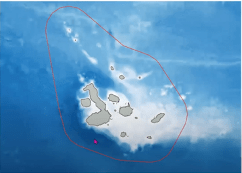
Screenshot Webinar „Shark Ecology at the Galapagos, Bild: CDF
Sharks are fish and have been around for 420 million years. Unlike most fish, their skeleton consists of cartilage, their jaws have several rows of teeth and they have several gill slits. At the moment there are known more than 500 species of sharks, whose appearance is very different. You can find sharks with body lengths from 15 cm (dwarf lantern shark) to 18 m (whale shark). Not all sharks are carnivores. Some feed on plankton, such as the basking shark, and some sharks are omnivorous, eating both meat and seaweed, such as the shovel-nosed hammerhead. Because of their great adaptability, sharks can be found in almost all sea areas from the poles to the tropics, in shallow water as well as in the deep sea.
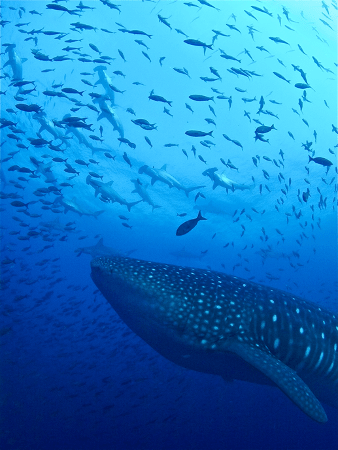
Whale shark & hammerheads @ Darwin Galapagos Pelayo Salinas
Sharks are ecologically very important and are therefore considered a keystone species. Although their numbers are small compared to other fish species, they have a great influence on the diversity of species in their habitat. Most sharks are predators and eat other predatory fish, preferring to prey on old or sick animals. This ensures that their populations remain constant and healthy. If the sharks are decimated too much, smaller predatory fish reproduce too much and their food requirements increase. As a result, more and more plant-eating fish are now being preyed upon, which leads to a proliferation of algae, which then overgrow and suffocate entire coral reefs.
Sharks are also economically important for the Galapagos Islands. Many visitors come here to dive with sharks and watch them off the islands of Darwin and Wolf. This can generate a turnover of up to $360,000 per shark, per year. If you compare this with the $158 that a fisherman receives for a shark fin, it is easy to see how important sharks are for the Galapagos economy.
In answering this question, anthropogenic (man-made) factors such as
- Overfishing
- Bycatch
- Cutting off the fins (Finning)
- Climate Change
- Pollution of the seas
- habitat reduction or loss
and biological factors such as
- Slow growth of sharks
- They grow up late which leads to late reproduction
- Few offspring due to reduced fertility
... are differentiated.
All these factors lead to shark populations being increasingly endangered.
The goal is to understand how the different shark populations in the Galapagos Marine Reserve (GMR) behave and develop. At the same time, the project aims to determine if existing protection measures for sharks in the GMR are effective enough. Another topic is the influence of the weather phenomenon El Niño on sharks. The researchers compare shark populations in the GMR with those in the Tropical Eastern Pacific (TEP) to determine similar behavioral patterns or migration routes between shark populations. Another focus is on education and public relations.
There are several ways to do this:
- DOVs (Driver operated Videos) - With their help divers create videos of sharks during the dive and evaluate them afterwards
- BRUVs (Baited remote underwater video) - These are cameras mounted on racks that are placed on the seabed with food to attract the fish.
- Acoustic transmitters - They are attached to the dorsal fin of the sharks. With your help you can determine if the shark has been in a certain area by installing acoustic receivers in that area. If a shark enters this area, its transmitter emits a sound which is recorded.
- Satellite Tags - They work like mobile phones. If a shark comes to the surface, the data collected is transmitted to the researchers via satellite. They are attached either during a dive with harpoons or by catching the sharks.
- Genetic analyses - They can be used to determine the age, sex or relationship of the sharks.
BRUV's were distributed throughout the archipelago. This way it was found that there are 10 different shark species in the GMR. Of all the fish observed in the videos, sharks make up only 1%.
Among the most common shark species found in the GMR are hammerhead shark (S.lewini), Galapagos shark (C.galapagensis), tiger shark (G. cuvier), silky shark (C. falciformis), white tip shark (T.obesus) and black tip shark (C.limbatus). They correspond to about 85% of all sharks observed in the GMR.
The largest number of different shark species can be found in the southern center around Santa Cruz, while the islands of Darwin and Wolf are home to the world's largest number of sharks compared to other fish. The high shark density is believed to be related to the nutrient-rich water and the protection measures against industrial fishing.
BRUV's also allowed the observation of rays and, for the first time in the GMR, a heptagonal shark.
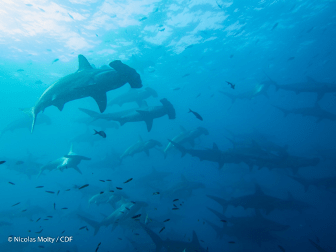
During the evaluation of data from satellite and acoustic transmitters on tiger sharks, it was found that these sharks spend more than 90% of their time in the GMR and even within the GMR they leave their territories very little. This behavior differs from that of tiger sharks in other places in the world. The researchers assume that the reason for this is the richness of food, especially the presence of their preferred prey, the green sea turtle. Further observations confirmed that most tiger sharks are found around the breeding grounds of the green sea turtles.
These are important components of the Shark Project. The Shark Ambassadors science club was created in 2017 for local students to learn more about marine life, including sharks with the aim of changin the negative reputation of sharks. It is important to educate the public about the importance of sharks for the marine ecosystem.
The Shark Ambassadors learn about scientific methods, but also learn to organize and carry out outreach campaigns in their local communities. For example, they created a video to commemorate World Ocean’s day where they highlighted of the recent event of 26 tons of shark fins confiscated in Hong Kong with Ecuadorean origin in May 2020. According to the authorities, more than 38'000 animals died!
A message from the Shark Ambassadors
Covid19 currently makes it impossible for researchers to do their field work. Fortunately, the analysis work can be continued, because there is still enough data available. In addition, the researchers use the time to write articles and publication, for training and organizing informational campaigns like this webinar.
At the moment, the tracking data of the hammerheads are being analyzed to get an overview of their migrations. Preferably pregnant animals are equipped with satellite transmitters as it is known that the hammerheads use coastal areas with mangroves as breeding grounds, but it is not clear how the young animals move. With the data obtained, the diving habits of the hammerheads can also be determined. Amazingly, the animals dive very deep (800 - 1'000 m). Exact reasons for this are not yet known to the researchers. So, there is still a lot to discover about these interesting and very important animals for the marine ecosystem!
